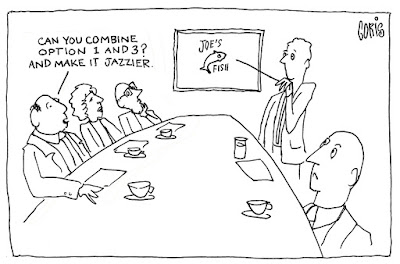One of the best ways to ensure that a brand identity is on track is to look at it often. And by look at it, I mean look at ALL of it. I like to keep a bulletin board or a wall of all the work we do for each client. If I had the space I’d use a real wall with real push pins tacking prints of everything in place. But a virtual wall works almost as well.
When you see everything like this in one place, something happens. You see consistencies. You see what strings everything together — colors, layouts, and messages that work, and more importantly, you notice inconsistencies.
Try making your own brand wall. The next time you’re ready to launch a new campaign, send an email blast, or publish a series of tweets, put it on the wall. How does it look? Will people recognize and connect it with everything else they’ve seen from you, in look, feel, tone, and message? Try it and see.
Tuesday, September 20, 2016
Thursday, January 14, 2016
How to Get Your Logo Approved
Anyone who has worked on a new logo initiative is probably familiar with this situation. You spend weeks, sometimes months, working on background, defining your brand, hammering out your messaging, and creating logo concepts—only to have it shot down by your board (or more likely one person on the board). Here are some ways to avoid this:
Get early buy-in. Anyone with veto power should be involved from the beginning. Gathering the whole team at a kickoff meeting and getting buy-in on the creative direction will encourage agreement in the long run. People want to be involved in the process, and the best time to do that is at the beginning. It costs you nothing and will often yield useful feedback that only improves the process, and results.
Back up the design. A good creative firm should provide you with a creative brief, that will describe the logo – not with specific images, but how it works in the context of the brand platform — before any design is presented. This ensures that the design is on track with your organization’s goals, and that every design has reasoning behind it.
Have a short version. An in-depth messaging document is often necessary for people involved in day-to-day marketing communications. But chances are slim to none that a board member will read a 25-page document. Write a synopsis with key points such as adjectives to describe the organization (3-5), short messages, audiences and goals of the organization and of the new design. Remind people of this when presenting concepts. People prefer simple in a pinch; additionally, taking the time to create a more nuanced version helps you really understand what you have set out to do.
Present in person. Bad things happen when creative concepts get shot into cyberspace and left to fend for themselves. The presence of at least one team member working on the logo can head off many potential disasters or naysayers simply by being able to explain a design, or some small part of it face-to-face. The psychology behind this is pretty simple: people are less likely to be critical in person. There are a lot of situations where creative is dismissed out of hand for some insignificant reason that could easily be addressed in a discussion.
Second best: create an online presentation. If it’s not possible to present concepts in person, a good alternative is an online presentation. Programs like Adobe Connect and GoToMeeting allow you the control the show with an orderly presentation. If you must email designs out to a group, be sure to do it just before the conference call, to minimize the time people have reacting to the work without the context of your presentation. Listen hard for the naysayers. There’s usually one in every group that can derail everything by influencing others with misguided notions. Often times these people just want to be heard. Pay special attention to their concerns and address them directly. Complimenting them on their input goes a long way here. Avoid at all costs having this discussion by email.
Involve your creative firm. Most people in business have been in this situation. We’ll be in a presentation with visual concepts and somebody says: “Oh! But what if we combined option 3 with option 1!” Once this happens, more people feel compelled to chime in. And before you know it, you’re on the road to the dreaded design by committee. Your creative team can help to head this off by keeping the conversation on problems to address rather that arrive at a solution from the group. They should be able provide an explanation as to how certain elements support or detract from your brand. Remember that people seeing it for the first time have no idea of the process or how many possibilities you sifted through to arrive at the logo you are presenting. A creative team is a check and balance that lets people know that their concerns were anticipated and tested.
If all else fails, try and understand why somebody “just doesn't like it.” Sometimes there is no recovery from this. A personal bias by a decision maker, is something you just have to suck up and deal with, no matter how perfect a solution you’ve presented. Your best hope is to try and get at an understanding of why they don’t like something. Ask. It may be something as simple as a typeface that reminds them of the time in junior high school when they were bullied for working on the yearbook – that used that font on the cover.

______________________________________
Excerpted from: Does This Logo Make Me Look Fat? A Marketing and Brand-Building Guide for Associations and Nonprofits, by Dennis Goris, 2016
Subscribe to:
Posts (Atom)


